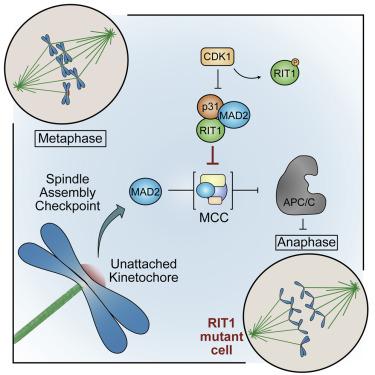Current Biology ( IF 9.2 ) Pub Date : 2021-07-07 , DOI: 10.1016/j.cub.2021.06.030 Antonio Cuevas-Navarro 1 , Richard Van 1 , Alice Cheng 1 , Anatoly Urisman 2 , Pau Castel 1 , Frank McCormick 1

|
The spindle assembly checkpoint (SAC) functions as a sensor of unattached kinetochores that delays mitotic progression into anaphase until proper chromosome segregation is guaranteed.1,2 Disruptions to this safety mechanism lead to genomic instability and aneuploidy, which serve as the genetic cause of embryonic demise, congenital birth defects, intellectual disability, and cancer.3,4 However, despite the understanding of the fundamental mechanisms that control the SAC, it remains unknown how signaling pathways directly interact with and regulate the mitotic checkpoint activity. In response to extracellular stimuli, a diverse network of signaling pathways involved in cell growth, survival, and differentiation are activated, and this process is prominently regulated by the Ras family of small guanosine triphosphatases (GTPases).5 Here we show that RIT1, a Ras-related GTPase that regulates cell survival and stress response,6 is essential for timely progression through mitosis and proper chromosome segregation. RIT1 dissociates from the plasma membrane (PM) during mitosis and interacts directly with SAC proteins MAD2 and p31comet in a process that is regulated by cyclin-dependent kinase 1 (CDK1) activity. Furthermore, pathogenic levels of RIT1 silence the SAC and accelerate transit through mitosis by sequestering MAD2 from the mitotic checkpoint complex (MCC). Moreover, SAC suppression by pathogenic RIT1 promotes chromosome segregation errors and aneuploidy. Our results highlight a unique function of RIT1 compared to other Ras GTPases and elucidate a direct link between a signaling pathway and the SAC through a novel regulatory mechanism.
中文翻译:

RAS GTPase RIT1 通过主轴装配检查点抑制损害有丝分裂保真度
纺锤体装配检查点 (SAC) 用作未连接的动粒的传感器,可延迟有丝分裂进入后期,直到确保正确的染色体分离。1 , 2这种安全机制的破坏会导致基因组不稳定和非整倍性,这是胚胎死亡、先天性出生缺陷、智力残疾和癌症的遗传原因。3 , 4然而,尽管了解了控制 SAC 的基本机制,但仍不清楚信号通路如何直接与有丝分裂检查点活动相互作用并对其进行调节。响应细胞外刺激,参与细胞生长、存活和分化的多种信号通路网络被激活,这一过程主要受小鸟苷三磷酸酶 (GTPases) 的 Ras 家族调节。5在这里,我们展示了 RIT1,一种调节细胞存活和应激反应的 Ras 相关 GTP 酶,6对于通过有丝分裂和适当的染色体分离及时进展至关重要。RIT1 在有丝分裂期间从质膜 (PM) 解离,并直接与 SAC 蛋白 MAD2 和 p31彗星相互作用在一个受细胞周期蛋白依赖性激酶 1 (CDK1) 活性调节的过程中。此外,RIT1 的致病水平使 SAC 沉默并通过将 MAD2 与有丝分裂检查点复合体 (MCC) 隔离来加速有丝分裂的转运。此外,致病性 RIT1 对 SAC 的抑制促进了染色体分离错误和非整倍性。我们的结果突出了 RIT1 与其他 Ras GTPases 相比的独特功能,并通过一种新的调节机制阐明了信号通路与 SAC 之间的直接联系。



























 京公网安备 11010802027423号
京公网安备 11010802027423号